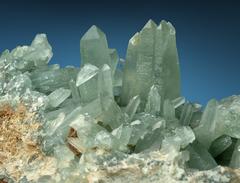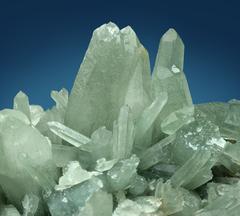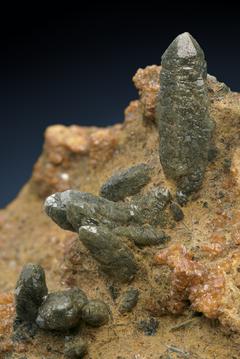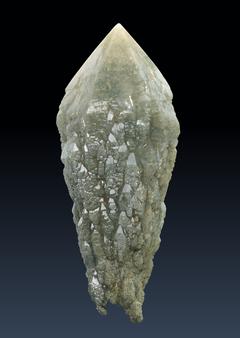last modified: Thursday, 25-Oct-2012 01:29:19 CEST
Document status: complete
"Prase" is a light to dark green macrocrystalline quartz variety. Originally, the term prase was more often used for massive macrocrystalline, sometimes microcrystalline, but rarely for well crystalline forms, but the recent availability of crystals from certain locations sold under that name has led to a shift in terminology. Crystals can be shiny, but usually are dull. I would consider naming a green chalcedony "prase" at least confusing, as there already is a term for chalcedony of similar color: "plasma". There is, however, no strict definition of what prase is. Here I will only describe the crystalline forms.
Specific Properties
The color of prase is caused by various green inclusions, more or less evenly distributed in the crystals. Quartz with chlorite inclusions, however green it may be, does usually not count as prase. The most common inclusion seem to be fibrous inclusions of amphibole minerals like actinolite, Ca2(Mg,Fe)5[(OH,F)|Si4O11]2. The pyroxene mineral hedenbergite CaFe[Si2O6] is frequently mentioned, but so far I have not found literature in which hedenbergite is confirmed as inclusions in quartz. In a personal communication Gerhard Niedermayr told me that, to his knowledge, so far all prase specimen studied (from localities including China, Greece, Russia, Italy) had actinolite or ferro-actinolite inclusions, and no hedenbergite.Since the fibrous inclusions interfere with crystal growth, prase crystals often have peculiar and characteristic shapes that may help to determine the provenance of the specimen.
Occurrence
Prase is typically found in so called skarns, rocks that formed when magma of igneous rocks intruded into carbonate rocks. The hot silica-rich fluids that escape from the cooling magma enter the neighboring carbonate rocks and cause chemical alterations and the formation of new minerals. Skarns are often associated with iron ore deposits. Common companions of quartz in these environments are pyroxenes (like hedenbergite), amphiboles (like actinolite), epidote, iron oxide minerals like hematite, and garnets.
Locations and Specimen
Prase is only found at very few locations. The most famous ones are the Island of Elba, Italy, and the Island of Serifos, Greece. Other locations include Dalnegorsk, Russia, and recently Morocco.
Greece

20mm 1024x1016 110kb - 2048x2032 316kb |
The crystals sit on a crumbly grey-green matrix of irregular grains that contains soft aggregates of fibrous mineral fibers. These are often said to be hedenbergite, but I am not sure if they are not made of actinolite that has also been found inside the prase crystals (Hyrsl and Niedermayr, 2003). They are sometimes accompanied by iron roses (hematite), one of them can be seen as a small aggregate of grey metallic crystals at the lower left corner.
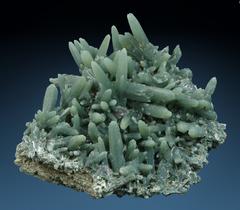
20mm 1200x1048 189kb - 2400x2096 552kb |
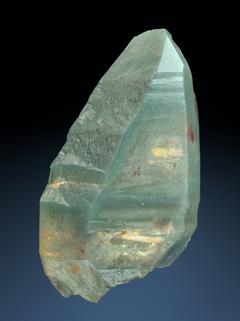
5mm 1024x1370 143kb - 2048x2740 431kb |
Italy
|
Prase from the island Elba often shows well developed crystal faces and prisms. The nicest pieces of prase I have seen so far are on exhibit at the Museo Minerali Elbani in Rio Marina, which is only a few kilometers away from the classic location Porticciolo.
Locals on Elba call prase "prasio", of course, the Italian name for prase. One could easily confuse prasio with prasiolite, which is very different. My attempts to find some prase myself were rather unsuccessful, but I've only searched for 2 hours. At least I found a very small green crystal embedded in an asbestos matrix, so I must have been at the right spot. It is at the eastern coast of Elba, south of Rio Marina. On the first picture you can see light brown needles of the asbestos the crystals are usually found in. The second picture just shows the flip side of the same specimen.
Morocco
Different from the specimen from Elba, there are no signs of fibrous or needle-like minerals in the matrix the crystals grew on. But in a small gap between the crystals I found very fine parallel fibers of gray-green color, possibly asbestos (second picture). The third picture is a detailed view of a crystal group from the same specimen.
Russia
Further Information, Literature, Links Printer Friendly Version Printer Friendly VersionCopyright © 2005-2013, A.C. A k h a v a n Impressum - Source: http://www.quartzpage.de/prase.html |

